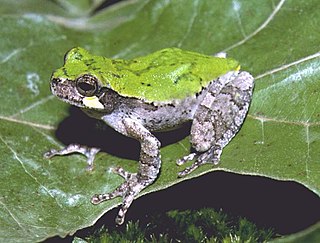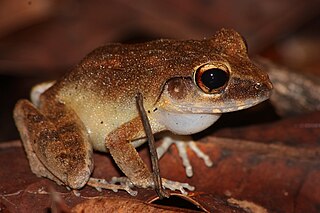
Platymantis is a genus of frogs in the family Ceratobatrachidae. They are commonly known as wrinkled ground frogs, ground frogs, and forest frogs.

The pink-billed parrotfinch is a species of estrildid finch found on the island of Viti Levu, Fiji. Commonly found at undisturbed mature forest in the centre and east of Viti Levu, e.g. Joske's Thumb near Suva. This species is found at mid-height along tree-trunks and branches, usually alone or in pairs but also joining mixed-species flocks, feeding primarily on insects, but also on flower buds and fruits.

The bird-voiced tree frog is a species of frog in the family Hylidae, endemic to the United States. Its natural habitats are temperate forests, shrub-dominated wetlands, and swamps.
Cornufer wolfi is a species of frog in the family Ceratobatrachidae. It is endemic to the Solomon Islands archipelago and known from the Buka and Bougainville Islands in Papua New Guinea and from the Santa Isabel and Choiseul Islands in the Solomon Islands. The specific name wolfi honours Eugen Wolf, a member of the Hanseatische Südsee-Expedition (1909) and writer of the expedition's travel report. Common name Wolf's sticky-toed frog has been coined for it.

Cornufer heffernani, sometimes known as the Solomon Island palm frog, is a species of frog in the family Ceratobatrachidae. It is endemic to the Solomon Islands archipelago where it can be found in at least Buka and Bougainville Islands of Papua New Guinea and Choiseul and Santa Isabel Islands of the Solomon Islands, but probably also more widely. The specific name heffernani honours Mr. N. S. Heffernan, who collected the type series.
Cornufer batantae is a species of frog in the family Ceratobatrachidae. It is endemic to West Papua, Indonesia, and is known from two islands near the New Guinean mainland, Batanta and Waigeo. There are also unconfirmed records from Yapen and Gag Islands. Common name Batanta wrinkled ground frog has been coined for the species.
Platymantis bimaculatus is a species of frog in the family Ceratobatrachidae. It is endemic to West Papua, Indonesia.
Cornufer boulengeri, commonly known as Boulenger's wrinkled ground frog or Boulenger's platymantis, is a species of frog in the family Ceratobatrachidae. It is endemic to New Britain Island in the Bismarck Archipelago, Papua New Guinea. The adults live on the forest floor of lowland and foothill rain forests, whereas juveniles occur low on the vegetation. It is potentially threatened by habitat loss caused by logging.
Cornufer cheesmanae is a species of frog in the family Ceratobatrachidae. It is endemic to New Guinea and found in the Cyclops Mountains and Bewani Mountains. The specific name cheesmanae honors Lucy Evelyn Cheesman, an English entomologist, explorer, and curator at London Zoo. Common name Cheesman's wrinkled ground frog has been coined for it.
Cornufer gilliardi, commonly known as Gilliard's wrinkled ground frog, is a species of frog in the family Ceratobatrachidae. It is endemic to the Whiteman Ranges of New Britain, Bismarck Archipelago. The specific name gilliardi honors Ernest Thomas Gilliard, an American ornithologist who, together with Margaret Gilliard, collected the holotype.
Cornufer hedigeri, commonly known as the Treasury wrinkled ground frog or Solomon Islands giant treefrog, is a species of frog in the family Ceratobatrachidae, named after Henry B. Guppy who collected the holotype from the Treasury Islands. It is widespread in the Solomon Islands archipelago, though it is missing from New Georgia and Makira islands.

Platymantis insulatus is a species of frog in the family Ceratobatrachidae. It is endemic to the Gigante Islands just northeast of Panay, the Philippines. This frog is variously known as the Gigantes wrinkled ground frog, island forest frog, South Gigante Island frog, Gigantes forest frog, and Gigantes limestone frog. Originally described from South Gigante, it is now known to occur on at least three other islands.

Cornufer macrops, also known as the Aresi wrinkled gound frog, is a species of frog in the family Ceratobatrachidae. The specific name macrops refers to the very large eyes of this species. It is endemic to Bougainville Island, in the Papua New Guinean part of the Solomon Islands archipelago. It is only known from the mountains of northern Bougainville Island, near Kunua, although its true range could be much wider.
Cornufer macrosceles is a species of frog in the family Ceratobatrachidae. It is endemic to the island of New Britain, Papua New Guinea. It is only known from the Nakanai Mountains in the central part of the island. Only three specimens are known. Common name Ti wrinkled ground frog has been coined for the species.

Cornufer papuensis is a species of frog in the family Ceratobatrachidae. It is found in the northern parts of New Guinea and in many surrounding islands, including the Bismarck Archipelago, D'Entrecasteaux Islands, Trobriand Islands, and Maluku Islands including Sula Islands and Seram Island (Indonesia). Common name Papua wrinkled ground frog has been coined for the species.
Cornufer punctatus, commonly known as the dotted wrinkled ground frog, is a species of frog in the family Ceratobatrachidae. It is endemic to Western New Guinea (Indonesia) and occurs in the Arfak and Wondiwoi Mountains in the Guinean mainland well as on some adjacent islands.
Cornufer schmidti is a species of frog in the family Ceratobatrachidae. It was first described as a subspecies of Platymantis papuensis. It is the type species of the subgenus Aenigmanura within Cornufer. It is endemic to the Bismarck Archipelago, Papua New Guinea, and is known from the islands of New Britain, New Ireland, and Manus; the Manus population might represent a distinct species.

Platymantis vitiensis is a species of frog in the family Ceratobatrachidae. It is one of two endemic frogs in Fiji, the other being the closely related Platymantis vitianus.

The Ceratobatrachidae are a family of frogs found in the Malay Peninsula, Borneo, the Philippines, Palau, Fiji, New Guinea, and the Admiralty, Bismarck, and Solomon Islands.

The Fiji tropical moist forests is a tropical moist forest ecoregion in Fiji and Wallis and Futuna. It covers the windward sides of Viti Levu and Vanua Levu, Fiji's largest islands, as well as the smaller Fijian islands and the three islands that make up Wallis and Futuna, an overseas territory of France.










